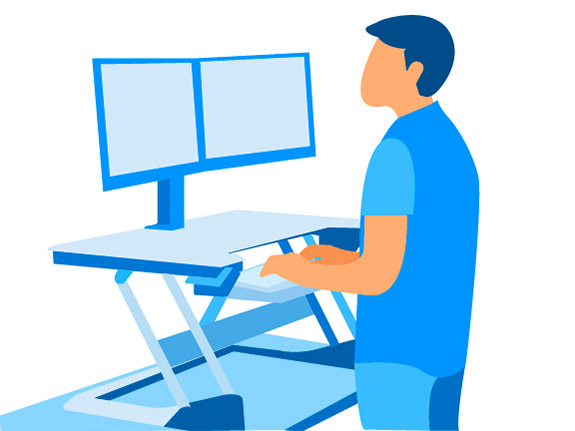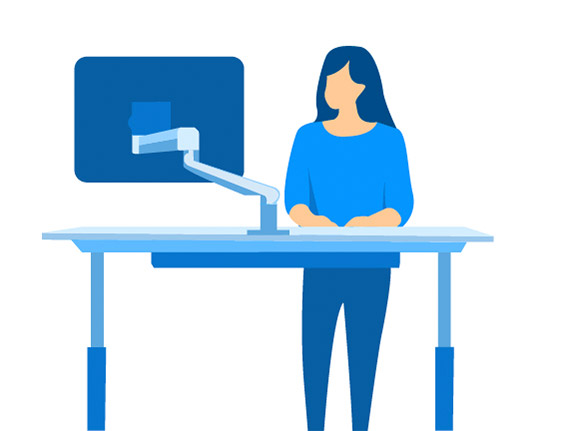
The Benefits of Using a Stand-Up Computer Desk
While research is still in its early stages, there are some
stand-up desk benefits that can improve your health and increase your productivity. Using this kind of desk can, at the very least, somewhat negate the harmful effects of being seated for long periods of time. Here are some of the benefits of using a stand-up computer desk, which are supported by science:
- It lowers your risk for weight gain and obesity — Weight gain is often caused by taking in more calories than you burn, while burning more calories than you take in will lead to weight loss. While exercise is the most effective way to burn calories, just choosing to stand instead of sitting can also have some benefits. Compared to an afternoon of sedentary work, an equal amount of time spent standing up has been shown to burn over 170 extra calories. So, you can burn almost 1,000 extra calories a week just from standing at your desk each afternoon. This kind of caloric difference is one of the reasons why sitting for long periods of time is strongly linked to obesity and metabolic disease.
- It can lower your blood sugar levels — The more your blood sugar increases after each meal, the worse it is for your health. This is especially true for people with insulin resistance or Type-2 Diabetes. In a small study of 10 office workers, standing for 180 minutes after lunch lowered their spike in blood sugar by 43% compared to sitting for the same amount of time. Both groups took the same number of steps, which was a clear indication that the smaller spike was a result of standing instead of physical movements around the office. Another study involving 23 office workers found that alternating between a standing and sitting position every 30 minutes throughout the workday reduced their blood sugar by 11.1% on average. In fact, excessive sedentary time is linked to a 112% greater risk for Type 2 Diabetes.
- It can lower your risk of heart disease — The idea that standing can benefit your heart health was first proposed in 1953. A study showed that bus conductors who stood all day had half the risk of death related to heart disease than their colleagues sitting in the driver’s seat. Since then, scientists have gotten a much better understanding about the effects that sitting has on a person’s heart health. In fact, staying sedentary for long periods of time can increase your risk of heart disease by up to 147%. It’s so harmful to your health that even an hour of intense exercise may not make up for the negative effects of spending an entire day sitting down, so there’s no doubt that spending more time on your feet can benefit your heart health.
- It can reduce back pain — Back pain is one of the most common complaints from office workers who sit all day. To find out if a stand-up computer desk can improve this, several studies were done on employees with long-term back pain. Those who participated said there was a 32% improvement in lower back pain after several weeks of using a standing desk. Another study that was published by the CDC found that using a sit-stand desk lowered upper back pain by 54% after only four weeks. And after they stopped being used, some of those improvements were reversed within two weeks.
- It can improve mood and energy levels — Standing desks can have a positive effect on your overall well-being. In a seven-week study, people who used a stand-up computer desk felt less stress and fatigue than those who remained seated for the entire workday. And 87% of those who used standing desks said they had more energy throughout the day. Once they went back to their old desks, their moods went back to their original levels.
- It can boost productivity — One of the most common concerns about using a stand-up computer desk is that it can be harder to perform daily tasks (such as typing). But in a study of 60 young office employees, using a standing desk for four hours every day had no impact on the number of characters they were able to type per minute and had no impact on their number of typing errors. So not only can a standing desk improve mood, but it can also boost productivity.
- It can help you live longer — Studies have found a link between sitting for long periods of time and early death. This isn’t surprising because of the strong connection between staying sedentary, type 2 diabetes, and heart disease. A number of studies have found that people who sit most often are at a 49% greater risk of dying early than people who sit the least. Another study showed that lowering your sitting time to about three hours a day would increase the American life expectancy by about two years. While these studies don’t necessarily prove cause and effect, the evidence does suggest that standing more often could increase your lifespan.
If you’re looking for the
best stand-up desk for your office or workspace, be sure to look at what we have at Engineer Supply.
The Right Way to Stand
There’s no question that moving around on a regular basis throughout your workday can be beneficial. But while there are
stand-up desk benefits, it doesn’t mean that you should stand all day because it can lead to other health problems (such as varicose veins, thrombosis, or blockage to the carotid arteries). You should alternate between sitting and standing by about 50% each way. Within that time frame, you should change your position about every 15-30 minutes. Your body gets acclimated to sitting after about 30 minutes, which will cause the muscles in your lower body to turn off. And you need to keep your metabolism working by promoting blood flow.
If you’re not used to standing for a particular length of time, you shouldn’t push yourself to a level of discomfort. Work with your own comfort level and ease yourself into it. Reducing your sedentary time can improve your physical, metabolic, and even mental health. That’s why using a stand-up computer desk can be an important lifestyle change. If you’re ready to buy the
best stand-up desk for your specific needs, feel free to look at what we have at Engineer Supply. We’re sure you’ll be able to find a product that will meet your specific needs.

Frequently Asked Questions
Can a stand-up computer desk be helpful?

According to a study that was published in the Journal of Physical Activity and Health, it’s not clear if standing instead of sitting behind a desk throughout the day will burn a significant amount of calories. It showed that standing burned 88 calories an hour, which isn’t a significant difference from the 80 calories an hour that was burned while sitting. But there’s one thing of which many studies have been clear — that spending long hours sitting down is linked to obesity, diabetes, heart disease, some forms of cancer, and a shorter life. So, it makes sense that standing would offset these risks.
How long should I stand at a standing desk?
You want to spend about 50% of each workday in a standing position by alternating between positions about every 15-30 minutes. Your body gets used to sitting after about 30 minutes. And when that happens, the muscles in your lower body start to turn off. The goal is the keep your metabolism working by promoting blood flow. That way, you can take advantage of all the
stand-up desk benefits.
What is the best stand-up desk?
There are many types and models of standing desks, and all of them are at different price points. So, you want to find the best stand-up computer desk for your budget and needs. Feel free to look at the broad selection we have at Engineer Supply, so you can find a product that’s right for you!
Why are standing desks so expensive?
If you’re looking to buy a stand-up computer desk, you have most likely have been turned off by the hefty price tag. They can cost hundreds of dollars (with premium brands going over $1,000), and the reason for this is simple. Because it’s an emerging technology with a great deal of benefits for office workers, the demand for standing desks have skyrocketed. And some companies may choose to take advantage of it by overpricing their products.
Where can I buy the best stand-up desk?
If you’re looking for the best place to buy a stand-up computer desk, you can find what you need at Engineer Supply. We have a broad selection from some of the best brands on the market. So if you’re ready to take advantage of all the
stand-up desk benefits, be sure to look at what we have in stock.